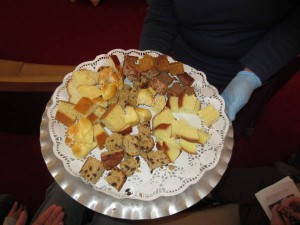Over the weekend at church, we had our annual Thanksgiving service, one of my favorites of the year.
Several members of the congregation bring bread: a great-grandmother’s recipe, the new recipe that the 4-year-old always requests, the gluten-free vegan recipe, or the bread they always pick up at Perreca‘s because nobody bakes at home. On the years we’ve baked, we’ve brought Cute W’s grandma’s banana bread or the shortbread (cheating, really, because it’s more like a cookie) that my mother bakes on Christmas morning. Everyone tells the stories behind their breads, then places them on a table with a centerpiece, gradually creating a gorgeous and bountiful display.
I meant to take a picture of it, but I was too enthralled with the stories. This service makes me weepy every time, whether it’s the story itself, or knowing that the grandmother they’re recalling has recently died, or watching a mother hover, worried that her toddler won’t deliver the bread to the table without dropping it on the floor. Each bread is offered with tender care and an earnest desire to convince you that you should adopt this bread at your house, too. It’s lovely to see people so proud of their heritage and their creation. But it’s even more moving to hear from someone who’s a little bit scared. They’ll begin with “I’ve never baked for myself, so this is my first try. . . .” or “My mother still always makes it better, but this gives you the idea. . . .” or they’ll end with an apology, “It collapsed a little on the end, but I promise it will still taste great.” So you end up with a loaf of family history and vulnerability and love. Sometimes, with a strudel topping.
By the end of the presentations, I always feel that I simply must try one or two specific breads. Of course, that’s easier said than done. It’s a lot of bread, and a huge group of volunteers descends on the table with knives, slicing the feast into bite-sized pieces and distributing them onto platters that are passed around.
It’s difficult to know exactly which bread is which. This year there was a flatbread I wanted to try and J wanted the “breakfast cake” bread. But we were flummoxed by the choices. In the end, as always, we had to surrender to the mother’s mantra: “you get what you get and you don’t get upset.” We make our choices, our best guesses. I bite and pause, tasting for echoes of the stories: it could be saffron, a reminder of a boisterous great aunt, or buttermilk that will taste, today, of loss and redemption. After the formalities of the service, there are always pieces left over and the members of the congregation circle the crumb-filled platters, eager for a taste of a story, or a new version of an old favorite, or just hungry for this home-baked communion.
Anyway, it’s lovely.
But I realized today that, really, we’re all having a little food communion this week. I called my sister because I hadn’t told her that I was bringing cheeseball to her house this weekend. She laughed and thanked me, but then said, basically, of course you are. You always bring the cheeseball at Thanksgiving. Well, I guess I do. It has origins in my parents’ courtship and a place in my childhood memory: I was always perplexed about why anyone would get so excited about something with (eeeww!) onions and peppers in it until maturity took hold and I, too, fell under its spell.
Not every dish will have a long and glorious history, true, but there is so much of ourselves wrapped up in food. And if you feel hassled at the holidays, this can almost be a meditation to look within and find grace in the stuffing. Whether it’s the sweet potatoes and marshmallows of a sister-in-law who tries too hard or the over-dry turkey of a grandmother too enthralled with a new grandbaby to focus on roast-time, the foods we prepare reflect our family histories and our personalities, too. Sharing them is a sacred offering to each other.
Amen.

